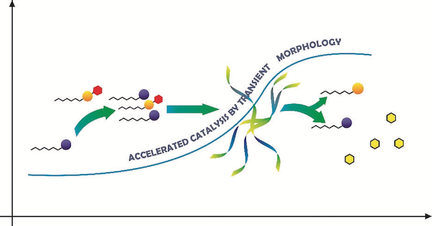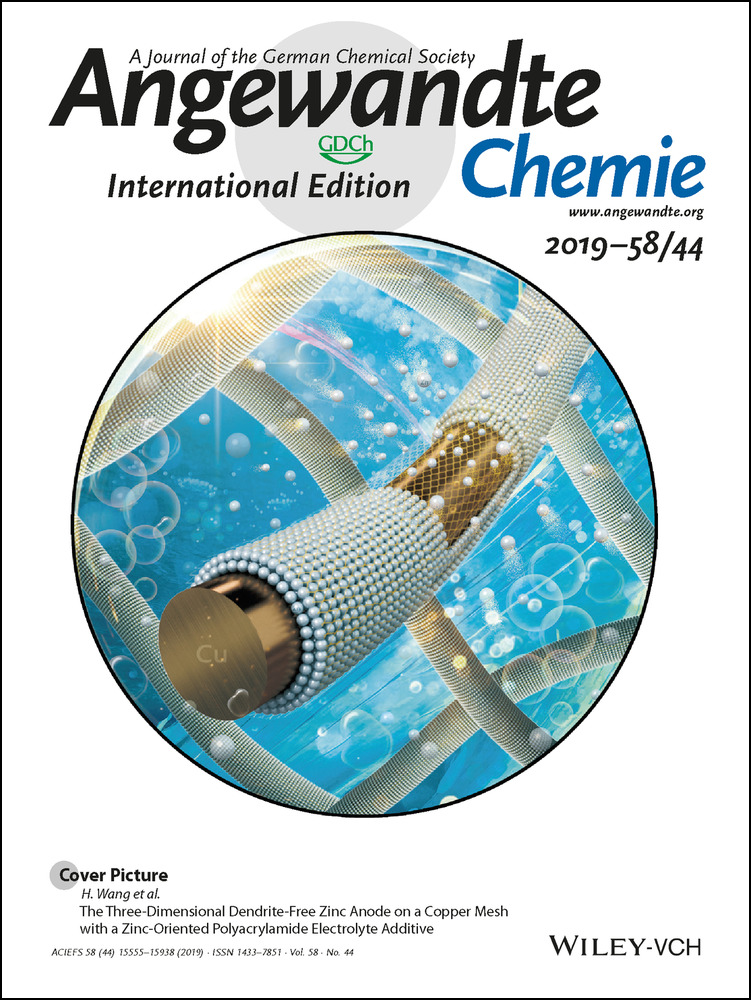Designed Negative Feedback from Transiently Formed Catalytic Nanostructures
Syed Pavel Afrose
Department of Chemical Sciences & Centre for Advanced Functional Materials, Indian Institute of Science Education and Research (IISER), Kolkata, Mohanpur, West Bengal, 741246 India
Search for more papers by this authorSubhajit Bal
Department of Chemical Sciences & Centre for Advanced Functional Materials, Indian Institute of Science Education and Research (IISER), Kolkata, Mohanpur, West Bengal, 741246 India
Search for more papers by this authorAyan Chatterjee
Department of Chemical Sciences & Centre for Advanced Functional Materials, Indian Institute of Science Education and Research (IISER), Kolkata, Mohanpur, West Bengal, 741246 India
Search for more papers by this authorKrishnendu Das
Department of Chemical Sciences & Centre for Advanced Functional Materials, Indian Institute of Science Education and Research (IISER), Kolkata, Mohanpur, West Bengal, 741246 India
Search for more papers by this authorCorresponding Author
Dibyendu Das
Department of Chemical Sciences & Centre for Advanced Functional Materials, Indian Institute of Science Education and Research (IISER), Kolkata, Mohanpur, West Bengal, 741246 India
Search for more papers by this authorSyed Pavel Afrose
Department of Chemical Sciences & Centre for Advanced Functional Materials, Indian Institute of Science Education and Research (IISER), Kolkata, Mohanpur, West Bengal, 741246 India
Search for more papers by this authorSubhajit Bal
Department of Chemical Sciences & Centre for Advanced Functional Materials, Indian Institute of Science Education and Research (IISER), Kolkata, Mohanpur, West Bengal, 741246 India
Search for more papers by this authorAyan Chatterjee
Department of Chemical Sciences & Centre for Advanced Functional Materials, Indian Institute of Science Education and Research (IISER), Kolkata, Mohanpur, West Bengal, 741246 India
Search for more papers by this authorKrishnendu Das
Department of Chemical Sciences & Centre for Advanced Functional Materials, Indian Institute of Science Education and Research (IISER), Kolkata, Mohanpur, West Bengal, 741246 India
Search for more papers by this authorCorresponding Author
Dibyendu Das
Department of Chemical Sciences & Centre for Advanced Functional Materials, Indian Institute of Science Education and Research (IISER), Kolkata, Mohanpur, West Bengal, 741246 India
Search for more papers by this authorGraphical Abstract
Abstract
Highly dynamic and complex systems of microtubules undergo a substrate-induced change of conformation that leads to polymerization. Owing to the augmented catalytic potential at the polymerized state, rapid hydrolysis of the substrate is observed, leading to catastrophe, thus realizing the out-of-equilibrium state. A simple synthetic mimic of these dynamic natural systems is presented, where similar substrate induced conformational change is observed and a transient helical morphology is accessed. Further, augmented catalytic potential of these helical nanostructures leads to rapid hydrolysis of the substrate providing negative feedback on the stability of the nanostructures and realization of an out-of-equilibrium state. This simple system, made from amino acid functionalized lipids, demonstrates a substrate-induced self-assembled state, where the fuel-to-waste conversion leads to the temporal presence of helical nanostructures.
Supporting Information
As a service to our authors and readers, this journal provides supporting information supplied by the authors. Such materials are peer reviewed and may be re-organized for online delivery, but are not copy-edited or typeset. Technical support issues arising from supporting information (other than missing files) should be addressed to the authors.
| Filename | Description |
|---|---|
| anie201910280-sup-0001-misc_information.pdf4.5 MB | Supplementary |
Please note: The publisher is not responsible for the content or functionality of any supporting information supplied by the authors. Any queries (other than missing content) should be directed to the corresponding author for the article.
References
- 1
- 1aJ. H. van Esch, R. Klajn, S. Otto, Chem. Soc. Rev. 2017, 46, 5474–5475;
- 1bB. A. Grzybowski, W. T. S. Huck, Nat. Nanotechnol. 2016, 11, 585–592.
- 2E. Mattia, S. Otto, Nat. Nanotechnol. 2015, 10, 111–119.
- 3E. te Brinke, J. Groen, A. Herrmann, H. A. Heus, G. Rivas, E. Spruijt, W. T. S. Huck, Nat. Nanotechnol. 2018, 13, 849–855.
- 4C. Pezzato, C. Cheng, J. F. Stoddart, R. D. Astumian, Chem. Soc. Rev. 2017, 46, 5491–5507.
- 5H. Hess, J. L. Ross, Chem. Soc. Rev. 2017, 46, 5570–5587.
- 6B. Alberts, A. Johnson, J. Lewis, M. Raff, K. Roberts, P. Walter, Molecular Biology of the Cell, 4th ed., Garland, New York, 2002.
- 7
- 7aS. A. P. van Rossum, M. Tena-Solsona, J. H. van Esch, R. Eelkema, J. Boekhoven, Chem. Soc. Rev. 2017, 46, 5519–5535;
- 7bR. K. Grötsch, C. Wanzke, M. Speckbacher, A. Angı, B. Rieger, J. Boekhoven, J. Am. Chem. Soc. 2019, 141, 9872–9878;
- 7cA. Sabatino, E. Penocchio, G. Ragazzon, A. Credi, D. Frezzato, Angew. Chem. Int. Ed. 2019, 58, https://doi.org/10.1002/anie.201908026; Angew. Chem. 2019, 131, https://doi.org/10.1002/ange.201908026.
- 8F. Della Sala, S. Neri, S. Maiti, J. L. Chen, L. J. Prins, Curr. Opin. Biotechnol. 2017, 46, 27–33.
- 9
- 9aG. Ragazzon, L. J. Prins, Nat. Nanotechnol. 2018, 13, 882–889;
- 9bR. D. Astumian, Nat. Commun. 2019, 10, 3837.
- 10S. De, R. Klajn, Adv. Mater. 2018, 30, 1706750.
- 11
- 11aR. Merindol, A. Walther, Chem. Soc. Rev. 2017, 46, 5588–5619;
- 11bN. Kapil, A. Singh, D. Das, Angew. Chem. Int. Ed. 2015, 54, 6492–6495; Angew. Chem. 2015, 127, 6592–6595;
- 11cN. Kapil, A. Singh, M. Singh, D. Das, Angew. Chem. Int. Ed. 2016, 55, 7772–7776; Angew. Chem. 2016, 128, 7903–7907.
- 12
- 12aG. Ashkenasy, T. M. Hermans, S. Otto, A. F. Taylor, Chem. Soc. Rev. 2017, 46, 2543–2554;
- 12bF. Wong, A. Sen, ACS Nano 2016, 10, 7172–7179.
- 13J. Boekhoven, W. Hendriksen, G. Koper, R. Eelkema, J. H. van Esch, Science 2015, 349, 1075–1079.
- 14
- 14aS. Maiti, I. Fortunati, C. Ferrante, P. Scrimin, L. J. Prins, Nat. Chem. 2016, 8, 725–731;
- 14bS. Panja, C. Patterson, D. J. Adams, Macromol. Rapid Commun. 2019, 40, 1900251;
- 14cH. Che, S. Cao, J. C. M. van Hest, J. Am. Chem. Soc. 2018, 140, 5356;
- 14dS. Panja, D. J. Adams, Chem. Commun. 2019, 55, 10154–10157.
- 15
- 15aA. Sorrenti, J. Leira-Iglesias, A. Sato, T. M. Hermans, Nat. Commun. 2017, 8, 15899;
- 15bD. Spitzer, L. L. Rodrigues, D. Straßburger, M. Mezger, P. Besenius, Angew. Chem. Int. Ed. 2017, 56, 15461–15465; Angew. Chem. 2017, 129, 15664–15669;
- 15cS. Ahmed, A. Chatterjee, K. Das, D. Das, Chem. Sci. 2019, 10, 7574–7578.
- 16F. della Sala, S. Maiti, A. Bonanni, P. Scrimin, L. J. Prins, Angew. Chem. Int. Ed. 2018, 57, 1611–1615; Angew. Chem. 2018, 130, 1627–1631.
- 17S. Debnath, S. Roy, R. V. Ulijn, J. Am. Chem. Soc. 2013, 135, 16789–16792.
- 18M. Kumar, N. L. Ing, V. Narang, N. K. Wijerathne, A. L. Hochbaum, R. V. Ulijn, Nat. Chem. 2018, 10, 696–703.
- 19S. Bal, K. Das, S. Ahmed, D. Das, Angew. Chem. Int. Ed. 2019, 58, 244–247; Angew. Chem. 2019, 131, 250–253.
- 20J. P. Wojciechowski, A. D. Martin, P. Thordarson, J. Am. Chem. Soc. 2018, 140, 2869–2874.
- 21C. Pezzato, L. J. Prins, Nat. Commun. 2015, 6, 7790.
- 22C. S. Wood, C. Browne, D. M. Wood, J. R. Nitschke, ACS Cent. Sci. 2015, 1, 504–509.
- 23J. L. Y. Chen, S. Maiti, I. Fortunati, C. Ferrante, L. J. Prins, Chem. Eur. J. 2017, 23, 11549–11559.
- 24X. Hao, W. Sang, J. Hu, Q. Yan, ACS Macro Lett. 2017, 6, 1151–1155.
- 25A. Mishra, D. B. Korlepara, M. Kumar, A. Jain, N. Jonnalagadda, K. K. Bejagam, S. Balasubramanian, S. J. George, Nat. Commun. 2018, 9, 1295.
- 26G. Wang, J. Sun, L. An, S. Liu, Biomacromolecules 2018, 19, 2542–2548.
- 27E. Del Grosso, A. Amodio, G. Ragazzon, L. J. Prins, F. Ricci, Angew. Chem. Int. Ed. 2018, 57, 10489–10493; Angew. Chem. 2018, 130, 10649–10653.
- 28L. S. Tobacman, E. D. Korn, J. Biol. Chem. 1983, 258, 3207–3214.
- 29T. David-Pfeuty, H. P. Erickson, D. Pantaloni, Proc. Natl. Acad. Sci. USA 1977, 74, 5372–5376.
- 30M. F. Carlier, D. Didry, D. Pantaloni, Biophys. J. 1997, 73, 418–427.
- 31G. M. Alushin, G. C. Lander, E. H. Kellogg, R. Zhang, D. Baker, E. Nogales, Cell 2014, 157, 1117–1129.
- 32R. Zhang, G. M. Alushin, A. Brown, E. Nogales, Cell 2015, 162, 849–859.
- 33D. Datta, C. L. McClendon, M. P. Jacobson, J. A. Wells, J. Biol. Chem. 2013, 288, 9971–9981.
- 34S. Cheng, G. Chang, C. Chou, Biophys. J. 2010, 98, 1327–1336.
- 35H. Fanlo-Virgós, A. R. Alba, S. Hamieh, M. Colomb-Delsuc, S. Otto, Angew. Chem. Int. Ed. 2014, 53, 11346–11350; Angew. Chem. 2014, 126, 11528–11532.
- 36P. Solís Muñana, G. Ragazzon, J. Dupont, C. Ren, J. Chen, L. J. Prins, Angew. Chem. Int. Ed. 2018, 57, 16469–16474; Angew. Chem. 2018, 130, 16707–16712.
- 37S. Lei, J. Zhang, J. Wang, J. Huang, Langmuir 2010, 26, 4288–4295.
- 38S. Onogi, H. Shigemitsu, T. Yoshii, T. Tanida, M. Ikeda, R. Kubota, I. Hamachi, Nat. Chem. 2016, 8, 743–752.
- 39A. R. Hirst, B. Huang, V. Castelletto, I. W. Hamley, D. K. Smith, Chem. Eur. J. 2007, 13, 2180–2188.
- 40W. Cui, X. Lu, K. Cui, J. Wu, Y. Wei, Q. Lu, Nanotechnology 2011, 22, 0957–4484.
- 41T. O. Omosun, M.-C. Hsieh, W. S. Childers, D. Das, A. K. Mehta, N. R. Anthony, T. Pan, M. A. Grover, K. M. Berland, D. G. Lynn, Nat. Chem. 2017, 9, 805–809.
- 42C. Zhang, R. Shafi, A. Lampel, D. MacPherson, C. Pappas, V. Narang, T. Wang, C. Madarelli, R. V. Ulijn, Angew. Chem. Int. Ed. 2017, 56, 14511–14515; Angew. Chem. 2017, 129, 14703–14707.
- 43C. M. Rufo, Y. S. Moroz, O. V. Moroz, J. Stöhr, T. A. Smith, X. Hu, W. F. DeGrado, I. V. Korendovych, Nat. Chem. 2014, 6, 303–309.
- 44C. Zhang, X. Xue, Q. Luo, Y. Li, K. Yang, X. Zhuang, Y. Jiang, J. Zhang, J. Liu, G. Zou, X. J. Liang, ACS Nano 2014, 8, 11715–11723.
- 45M. O. Guler, S. I. Stupp, J. Am. Chem. Soc. 2007, 129, 12082–12083.
- 46Y. Lin, Y. Qiao, Y. Wang, Y. Yan, J. Huang, J. Mater. Chem. 2012, 22, 18314–18320.





